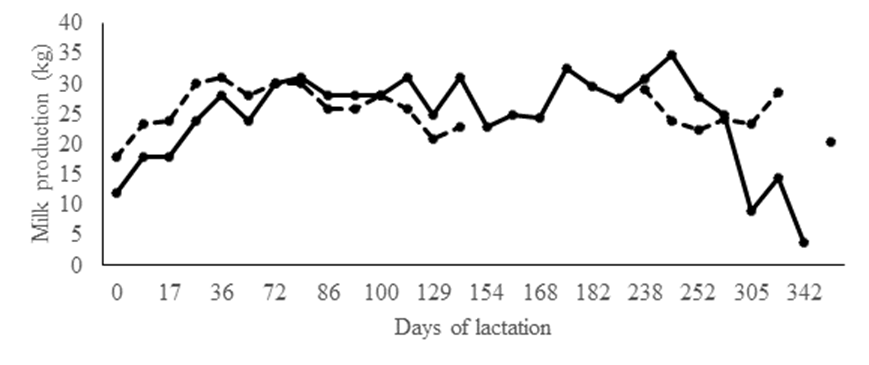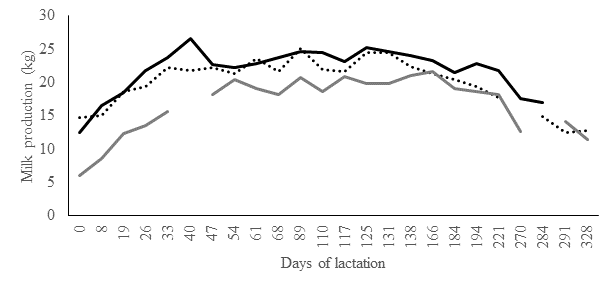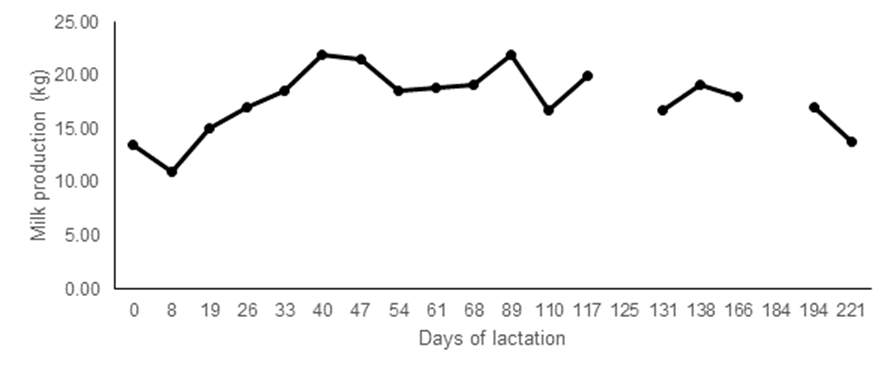Artificial lactation induction is achieved by exogenous hormone administration to cows that fail to initiate a new lactation after a dry period1. The decision to artificially induce a cow to produce milk might be a subject of debate. It is necessary to take into consideration that cows induced to produce milk very often suffer reproductive disorders due to the large number of hormones required to stimulate udder growth and function2. On the other hand, lactation induction means another opportunity for a cow to avoid culling and to stay productive on the dairy farm for a longer time than would be expected3.
Progesterone and estradiol are supplemented to cows for several days to stimulate udder alveoli and duct growth4. Progesterone is supplemented to cows by injections and intravaginal devices. Formation of an accessory corpus luteum is an alternative way to increase endogenous progesterone concentration5. Erb and colleagues reported concentrations of blood progesterone in cows induced to lactation using progesterone injections similar to those reported in cows with an accessory corpus luteum5,6. Therefore, it seems logical that extra endogenous progesterone produced by an accessory corpus luteum would be enough to sustain udder development during lactation induction. However, what is known, this approach has never been tested in a lactation induction protocol. Also, there are not information of the specific dose requirement of estradiol to induce lactation. Therefore, the tested hypothesis was that lactation induction in cows can be accomplished without exogenous progesterone supplementation and with reduced doses of estradiol.
The study was conducted in two phases. Phase one was a pilot test to gather information about the effectiveness of the protocol to induce lactation. This phase was carried out using two 6- to 7-yr-old Holstein cows with at least two calving, and one year off milking. The recurrent abortions were the common cause of reproductive failure in both cows, but they were not culled because of their high genetic value. A modification of the methods previously described for lactation induction was carried out in the two cows7,8.
The reproductive cycle of the cows was synchronized by two injections of 500 µg of cloprostenol (Celosil®, MSD Animal Health) administered at 14-d intervals. The cows were monitored every 6 h by visual observation to detect standing heat after the second injection of cloprostenol. A cow was declared in standing heat when she stood to be mounted by another cow. The cows’ ovaries were scanned on d-5 after detecting standing heat by ultrasonography (Aloka Prosund 2, 7.5 MHz transducer, Hitachi Aloka Medical, Ltd Japan). After the presence of a corpus luteum was confirmed, location of the largest follicle was registered, and an injection of 250 µg of gonadorelin acetate (GnRH®, Sanfer) was administered to cows. The ovaries were scanned every 12 h after GnRH injection until disappearance of the previously registered follicle. Once the largest follicle disappeared (within 48 h after GnRH injection), formation of an accessory corpus luteum was assumed9, and the lactation protocol began.
The recombinant bovine somatotropin (Lactotropina®, Elanco), estradiol benzoate (Benzoato de estradiol®, Syntex), cloprostenol, and dexamethasone ((Lapicor®, Lapisa) were used to induce lactation. The protocol lasted 21 d. The cows were injected with 500 mg of somatotropin on days one, eight, fourteen, and twenty-one. Estradiol benzoate (7.5 mg d-1) was applied from d-1 to 14. The udder of each animal was massaged for periods of one to two minutes in the morning and afternoon from d 16 to 20. The cloprostenol (500 µg) was administered to cows in the morning and afternoon on d 18. Dexamethasone (5 mg d-1) was injected from days 18 to 21. The cows were milked for the first time on d 22. The somatotropin was further administered to cows every 14 d after the first milking.
The cows (n= 3) had at least two calving and one year off milking, but they were not culled due to their high genetic value. The heifers (n= 4) were inseminated at least five times without pregnancy success. The common cause of reproductive failure in cows was recurrent abortions, while a closed cervix that prevent the delivery of semen into the uterus, and persistent uterine infections were observed in heifers.
The reproductive management of animals was the same as in phase I. The same protocol used to induce lactation in phase I was applied to cattle in phase II, but the dose of estradiol benzoate was modified. The animals were assigned to one of four different groups (GI-GIV). Group GI, a 2-yr-old heifer (671 kg), was injected with 3 mg d-1 of estradiol benzoate. Group GII, a 4-yr-old heifer (651 kg) and an 8-yr-old cow (580 kg), were treated with 5 mg d-1 of estradiol benzoate. Group GIII, a 4-yr-old heifer (737 kg) and an 8-yr-old cow (844 kg), were treated with 7.5 mg d-1 of estradiol benzoate. Group IV, a 3-yr-old heifer (753 kg) and an 8-yr-old cow (691 kg), were injected with 10 mg day-1 of estradiol benzoate.
The animals in phase I and II were fed corn silage ad libitum and 4 kg of commercial concentrate a day (Ganadero 18, Productos Agropecuarios Tepexpan, S.A. de C.V. (protein 18%, fat 4%, fiber 12%) before the first milking. After the first milking, the cows and heifers were located in the same pen and fed with a mixed ration through the experimental period (21.9 kg of fresh alfalfa, 21.9 kg of corn silage and 7.7 kg of the commercial concentrate as fed once a day to each cow).
The measured response variable was daily milk production, which was measured once a week from the first day to day 328 of milking. However, measurements were stalled at 221 d in milk for a heifer in GI due to low milk production.
The phase one was a pilot test and their data is not included in the statistical analysis. However, a descriptive analysis of the data from his phase is shown in the results section. An experiment with repeated measures was used in a randomized complete block design, assuming a first-order autoregressive structure among times for the variance-covariance matrix. Only two blocks were used, one made up of heifers (never calving) and the other of cows with more than two calving. The statistical analysis was performed using the statistical package Infostat (2018). Lactation was induced in cows of phase I. Average milk production of each cow was 25.5 ± 1.33 and 24.6 ± 1.18 kg d-1. The milk production pattern across lactation for both cows is shown in Figure 1.

Cow 1 (solid line) and cow 2 (dotted line)
Figure 1 Milk production of cows induced to lactation without exogenous progesterone supplementation
Milk production of cow and heifer in GIV was lower (P≤0.05) than that of cows and heifers in groups GII and GIII. Average milk production was 20.06 ± 0.73, 19.54 ± 0.71 and 18.36 ± 0.72 kg d-1 for cows and heifers in GII, GIII, and GIV, respectively. The differences in milk production between GII and GIII were not significant (P˃0.05). The milk production pattern of groups GII-GIV is depicted in Figure 2. Figure 3 depicts milk production of the heifer in GI. Statistical comparison between this and the rest of the groups was not possible due to the lack of replications.

Figure 2 Milk production of Holstein cows and heifers induced to lactation without exogenous progesterone supplementation and injected with different doses of estradiol benzoate (black line: 5, gray lines: 7.5 and dotted line: 10 mg d-1) for 14 d.

Figure 3 Milk production in a Holstein heifer induced to lactation without exogenous progesterone supplementation and injected with 3 mg d-1 of estradiol benzoate for 14 d
A modification of the lactation induction methods described by Mellado et al. and Freitas et al. was proposed7,8. The main modifications are that no exogenous progesterone is applied, and lower doses of estradiol benzoate and glucocorticoids are used. In addition, hormones (estradiol and glucocorticoids) are prescribed by day and not according to animal live weight.
The results of the present study show that lactation induction can be achieved without exogenous progesterone supplementation in combination with reduced doses of estradiol benzoate. The ovarian follicles and corpus luteum are the main sources of estradiol and progesterone in non-pregnant cattle. Therefore, manipulation of endogenous production of these hormones to favor udder development during lactation induction is reasonable. In this regard, Mohan et al mentioned that milk production was higher in heifers induced to lactation after estrus synchronization protocol than in those induced to lactation on random days of the estrous cycle10, probably due to a synergic effect of the steroid hormones naturally produced by the new follicles and corpus luteum after estrus synchronization with those injected.
The injections of estradiol and progesterone are necessary to induce lactation in cattle11. An attempt to induce lactation using only estradiol benzoate has been successfully carried out in heifers, but with poor results in cows12. In addition, average milk production was low (3.4 to 9.6 L d-1), regardless of whether estradiol benzoate was injected alone or in combination with progesterone. The lack of bovine somatotropin in Harnes and colleague's lactation induction protocol might explain the obtained results in milk production. Previous studies reported milk production in cows (18.9-28.4 kg d-1) similar to that found in the present study, but cows were injected with progesterone and with higher doses of estradiol benzoate7,8. Therefore, based on the results, it seems that endogenous progesterone is sufficient to stimulate udder development and milk production.
Estradiol benzoate is prescribed to cattle according to animal live weight13 or by day14, as in the present study, to induce lactation. To date, there is no estradiol benzoate prescription to stimulate udder growth and milk production. In the present study, 3 to 10 mg d-1 of estradiol were effective to induce lactation. Researches induced lactation in cattle by injecting 2.4 and 3.3 mg d-1 of estradiol benzoate, which is similar to the lower dose used in this study, but milk production was low (< 7 L d-1)15,16. The differences in milk production might due to the use of bovine somatotropin.
The injection of estradiol can cause a follicular cyst17. Follicular cysts cause an undesired and recurrent standing heat behavior in cattle. This kind of behavior has been reported in lactation induced cattle15,18. The heifers and cows used in the present study only showed standing heat behavior once during execution of the lactation induction protocol, but never in an abnormal recurrent way after its termination. Therefore, it can be assumed that reproductive behavior is not altered by the proposed lactation induction protocol.
Today, the implementation of induced lactation protocols on dairy farms may seem unnecessary because of the large supply of heifers, which makes the decision of culling cows with productive or reproductive issues easier. However, the easiest decision may not be the most adequate. Reasons for culling cows may be related to reduced animal welfare, which makes man nor the cow itself mainly responsible for shortening the lifespan of high producing cows on dairy farms3. Therefore, artificially induced lactation is another chance to improve general management to ensure a larger life span of cows. On the other hand, hormone traces in the milk of lactation-induced cows are a concern for human health19. However, estradiol concentrations return to basal concentrations 8 d after the last injection, and not differences have been found in estradiol blood concentrations between lactating heifers 17 d after calving and lactation-induced heifers20,21. Thus, after a period of 8 to 17 d, milk from lactation-induced cows can be used to feed humans or calves.
The lack of exogenous progesterone injections and the reduced doses of estradiol benzoate used in the proposed lactation induction protocol is affordable and especially favors small farm holders, who might find it difficult or too expensive to raise or buy a replacement heifer.
The disappearance of the largest follicle at d-5 of the estrous cycle and after GnRH injection was taken as a sign for accessory CL formation9. However, the actual formation of an accessory CL was not confirmed and blood progesterone concentrations were not measured, which stop the authors to conclude that an increment in blood progesterone concentrations occurred in the animals. However, since the lactation induction was successful in cows and heifer, it can be safely state that endogenous progesterone produced by a single or multiple corpus luteum is sufficient to stimulate udder growth during a lactation induction protocol in cattle.
The milk yield during lactation in cattle is determined by several factors, such as genetics, season, and parity22-24. The effect of parity and season on milk yield has been studied in cows induced to lactation, the highest milk production was observed at the fifth lactation, and during the fall and winter24. An unsuccessful approach to study the effect of genetics on milk production in lactation-induced animals was carried out in ewes25, it was observed that the number of ewes with a positive response to the lactation induction protocol was affected by breed. In the present study, the cows and heifers were induced to lactation during the same season and they were subjected to the same management practices and nutrition (animals were allocated in the same pen during the entire experiment). In addition, the animals belong to the same breed and the effect of parity was considered during the statistical analysis of the information. Therefore, it is suggested that the differences in milk production among experimental groups could be related to different responses of the animals to the hormonal treatment25 and the genetic merit for milk production26.
Endogenous progesterone production in combination with reduced doses of estradiol benzoate is sufficient to induce lactation in Holstein cattle. However, the small sample size used in the present study do not allow to fully guaranty the effectiveness of the proposed protocol at commercial level.











 texto en
texto en 


